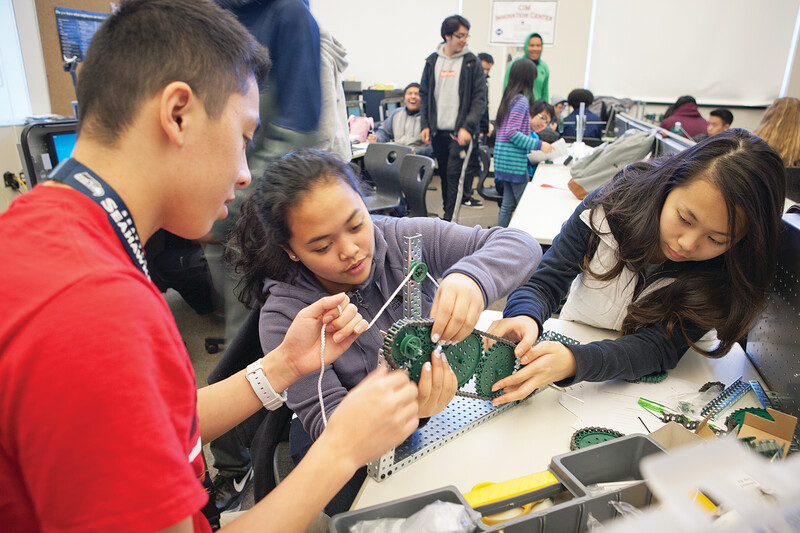Let's face it—the traditional classroom structure is not conducive to personalized learning. Lack of time, little flexibility, and scarce resources lead many teachers to design a single lesson for an entire class as their default approach to instruction. This approach, although common, does not meet individual students' needs.
For the first five years of my teaching career, I also taught this way. But technology and the potential of blended learning have helped me embrace a more student-centered approach. For example, in the Station Rotation model, students move through a series of learning stations. By incorporating online activities into at least one of these stations, we can draw on the benefits of technology to increase personalization.
As a secondary teacher trained in the stand-and-deliver model, I faced a big adjustment in shifting to Station Rotation. Many secondary teachers are concerned that their class periods won't provide enough time to use this model. I quickly discovered, however, that a Station Rotation can span more than one day. And despite the steep learning curve, I also realized this structure allowed me to create smaller learning communities within my larger class, to group students strategically, to adjust instruction and practice for specific students, and to make the most of my limited technology resources.
A Three-Station Design
Here are some tips on how I design a basic lesson that includes three types of stations: a teacher-led station, an online station, and an offline station.
The Teacher-Led Station: Providing Small-Group Instruction
By including one teacher-run station, you can group students strategically and adjust instruction for each group of students that moves through that station. I affectionately call my teacher-led station "Tucker Time." In this station, even my shyest students lean in, ask questions, and engage. It's less intimidating for them to speak up in a small group of six or seven students.
If students are learning how to write a thesis statement, for instance, I group them by writing ability. When my strong writers come through my station, I provide a brief explanation of what a thesis statement includes. That's about all these high-level writers need before they begin writing their own thesis statements. Then I shift into a coaching role and provide one-on-one feedback to help them refine and improve their writing. When my low-level writers come through my teacher-led station, my instruction is slower and more detailed. I model how to write a thesis statement for a sample prompt so they can hear me talk through the process. For my English language learners, I provide a thesis-statement sentence frame.
The small-group dynamic of the teacher-led station makes it easier to gauge where students are and support them in developing their skills. This is a natural space for real-time editing and feedback. I frequently use Tucker Time for synchronous editing in Google Docs. As students work on their pieces, I use "Suggesting" mode to provide immediate feedback. If I need to follow up with a student in more detail, it's easy because he or she is sitting right across from me. If I see a student struggling with a specific aspect of writing, such as passive versus active voice, I can pause and assign that student to complete a practice exercise on NoRedInk, an adaptive online grammar and writing tool.
The Online Station: Accommodating Learning Needs
To take advantage of the benefits of blended learning, at least one station must be an online station. Obviously, a teacher in a 1:1 classroom can opt to design multiple online stations, but I don't recommend that students engage with screens at every station. Variety is key to maintaining student interest, so it's best to mix things up.
I frequently use my online station to provide personalized practice. For example, I use the free version of Vocabulary.com, which designs vocabulary review lessons for each student on the basis of his or her performance. If a student consistently misses a word, it will continue to resurface in the review until the student demonstrates mastery of that word. I also use NoRedInk to individualize grammar practice. I can have some students work on how to use commas for clarity while other students learn about parallel structure.
The Offline Station: Thinking Outside the Box
Offline stations can take many different forms. These stations should encourage communication, collaboration, and problem-solving. Students can play a game, tackle a design thinking challenge, build something, or work on a project. My offline station often engages students in tactile and artistic tasks, but the activities there can also encourage students to learn from one another and develop interpersonal skills. For example, my students have recently discussed topics like "What is revealed about the mental health of characters in Romeo and Juliet from their behavior in the play?" or "How can teens distinguish between real and fake news?" My strongest students facilitate the conversations.
I enjoy designing choice boards that look like a tic-tac-toe game board. Each square has an activity, and students get to select the three in a row that they want to complete. This builds student agency and choice into offline stations to make them more fun and engaging.
A Powerful Blend
Before online tools and resources became so widely available, it was difficult for teachers to imagine providing instruction that met every student where he or she was. Now, we can add blended learning features to well-known instructional models like Station Rotation. This combination means that even teachers with limited access to technology can get closer to our goal of personalizing learning for all students.








